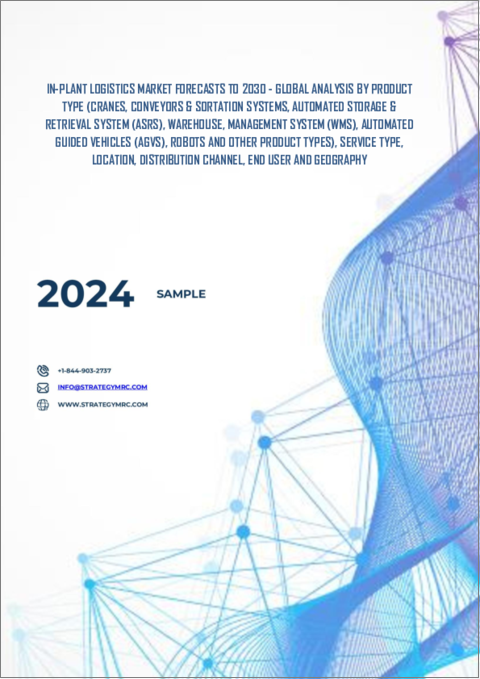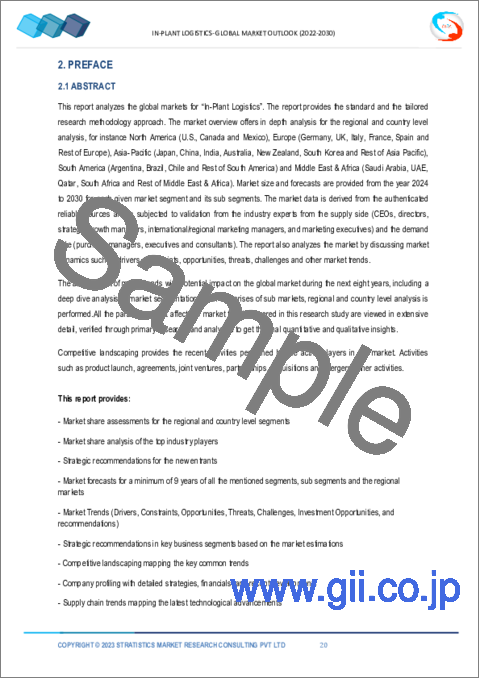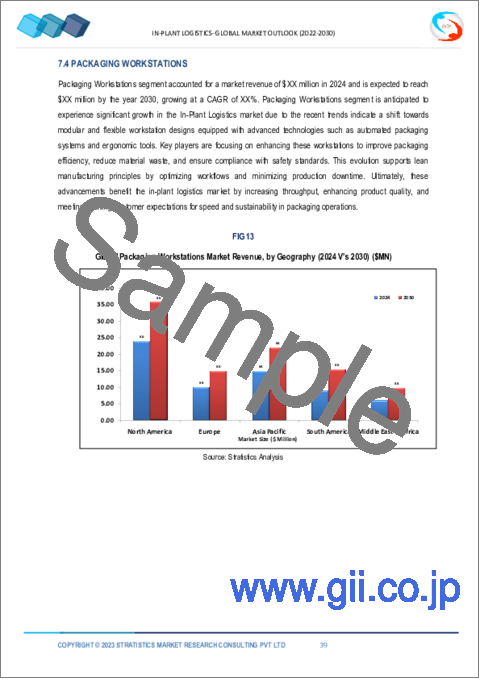|
|
市場調査レポート
商品コード
1558281
工場内物流市場の2030年までの予測:製品タイプ、サービスタイプ、ロケーション、流通チャネル、エンドユーザー、地域別の世界分析In-Plant Logistics Market Forecasts to 2030 - Global Analysis By Product Type, Service Type, Location, Distribution Channel, End User and By Geography |
||||||
カスタマイズ可能
|
|||||||
| 工場内物流市場の2030年までの予測:製品タイプ、サービスタイプ、ロケーション、流通チャネル、エンドユーザー、地域別の世界分析 |
|
出版日: 2024年09月06日
発行: Stratistics Market Research Consulting
ページ情報: 英文 200+ Pages
納期: 2~3営業日
|
全表示
- 概要
- 図表
- 目次
Stratistics MRCによると、世界の工場内物流市場は2024年に139億米ドルを占め、予測期間中のCAGRは13.2%で成長し、2030年には292億米ドルに達する見込みです。
インプラント・ロジスティクスは、製造または生産施設内の資材、商品、資源の内部移動を管理し最適化することを含みます。これには、在庫管理、マテリアルハンドリング、保管などの活動の計画、実施、管理が含まれ、円滑で効率的なオペレーションを保証します。その目的は、プロセスを合理化し、遅延を最小限に抑え、資材が適切な場所と時間に利用できるようにすることで生産性を向上させ、最終的に製造ワークフロー全体をサポートし、運用コストを削減することです。
国際エネルギー見通し2019年によると、米国エネルギー情報局(EIA)は、世界のエネルギー消費量は2018年から2050年の間に50%増加すると予測しています。
効率的なサプライチェーン管理への需要の高まり
市場における効率的なサプライチェーン管理に対する需要の高まりは、業務の合理化とコスト削減の必要性によってもたらされています。企業は競争力を強化しようとするため、社内のマテリアルハンドリング、在庫管理、ワークフロープロセスを最適化するための先進技術や戦略を採用する傾向が強まっています。同市場における効率的なサプライチェーン・マネジメントは、資材のタイムリーな供給を保証し、生産性を高め、製造目標全体をサポートします。
複雑な統合プロセス
市場における複雑な統合プロセスは、業務上の大きな課題と非効率につながる可能性があります。このような複雑なシステムは、特殊な技術を必要とするため、コストが高くなることが多いです。また、導入の遅れを引き起こし、ワークフローを混乱させ、全体的な生産性を低下させることもあります。さらに、複雑さゆえにエラーやシステム障害の可能性が高まり、マテリアルハンドリングに影響を与え、最終的には製造プロセスの円滑な運営と顧客満足度に影響を与える可能性があります。
データ分析と予知保全の成長
市場で拡大するデータ分析と予知保全は、リアルタイムのデータと高度なアルゴリズムを活用することで、業務効率を変革しています。データ分析により、企業はマテリアルフロー、在庫レベル、プロセスパフォーマンスに関する洞察を得ることができ、より多くの情報に基づいた意思決定とリソース配分の最適化につながります。予知保全は、データを利用して機器の故障を事前に予測し、ダウンタイムを短縮して保全コストを最小限に抑えます。
高い初期投資コスト
市場における高額な初期投資コストは、多くの組織にとって参入への大きな障壁となります。先進的なロジスティクス・テクノロジーやシステムを導入するには、機器、ソフトウェア、インフラストラクチャーに多額の資本支出を必要とすることが多いです。こうしたコストは、特に中小企業にとっては困難な課題となりうる。多額の投資が必要となるため、最新のソリューションの導入が遅れ、財務の安定性を維持しながら業務効率と競合優位性を達成する企業の能力に影響を与える可能性があります。
COVID-19の影響:
COVID-19の大流行は、サプライチェーンを混乱させ、オペレーションの優先順位を変えることで、インプラント・ロジスティクス市場に大きな影響を与えました。ロックダウンや社会的距離を置く措置によって労働力の稼働率が低下し、業務に遅れが生じる一方、特定の商品に対する需要の高まりが物流プロセスを緊張させました。企業は在庫管理とマテリアルフローの課題に直面し、ロジスティクス戦略の再評価を促しました。パンデミックは、自動化とデジタルソリューションの採用を加速させ、企業はサプライチェーン・オペレーションにおける回復力と適応力の強化を求めました。
予測期間中、倉庫管理分野が最大となる見込み
倉庫管理は、予測期間中に最大となる見込みです。円滑なマテリアルハンドリングとタイムリーな配送を確保するために、在庫管理、注文処理、スペースの最適化が含まれます。効果的な倉庫管理は、商品の流れを合理化し、保管コストを削減し、エラーを最小限に抑えることで業務効率を高める。自動化システムやデータ分析などの先進技術は、精度の向上、在庫レベルの管理、全体的な生産目標のサポートにますます統合されています。
予測期間中、消費財分野のCAGRが最も高くなると予想される
消費財セグメントは予測期間中、最も高いCAGRが見込まれています。消費財のロジスティクスには、高い消費者需要と季節変動に対応するための正確な在庫管理、迅速な注文処理、合理化された材料フローが含まれます。自動化とリアルタイムの追跡を含む効果的な工場内物流ソリューションは、保管の最適化とリードタイムの短縮に役立ちます。消費財のタイムリーで正確な配送を確保することで、顧客満足度を高め、サプライチェーン全体の効率をサポートします。
最大のシェアを占める地域
北米は、自動化と技術の進歩により、予測期間中最大の市場シェアを占めると予測されます。同地域の強固な製造基盤と業務効率重視の姿勢が、自動保管システムを含む高度なロジスティクス・ソリューションの採用を後押ししています。企業は、マテリアルハンドリングを合理化し、在庫管理を改善し、全体的な生産性を高めるために最新技術に投資しており、この地域を革新的な工場内物流ソリューションのリーダーとして位置づけています。
CAGRが最も高い地域:
予測期間中、アジア太平洋地域のCAGRが最も高くなると予測されます。急速な工業化とeコマースおよび消費財セクターの成長が、自動化やデータ分析といった高度なロジスティクス技術の必要性を煽っています。同地域の企業は、在庫管理の最適化、マテリアルハンドリングプロセスの改善、業務効率の向上のためにこれらのイノベーションを採用しており、工場内物流における同地域のダイナミックな成長に寄与しています。
無料のカスタマイズサービス:
本レポートをご購読のお客様には、以下の無料カスタマイズオプションのいずれかをご利用いただけます:
- 企業プロファイル
- 追加市場プレイヤーの包括的プロファイリング(3社まで)
- 主要企業のSWOT分析(3社まで)
- 地域セグメンテーション
- 顧客の関心に応じた主要国の市場推計・予測・CAGR(注:フィージビリティチェックによる)
- 競合ベンチマーキング
- 製品ポートフォリオ、地理的プレゼンス、戦略的提携に基づく主要企業のベンチマーキング
目次
第1章 エグゼクティブサマリー
第2章 序文
- 概要
- ステークホルダー
- 調査範囲
- 調査手法
- データマイニング
- データ分析
- データ検証
- 調査アプローチ
- 調査情報源
- 1次調査情報源
- 2次調査情報源
- 前提条件
第3章 市場動向分析
- 促進要因
- 抑制要因
- 機会
- 脅威
- 製品分析
- エンドユーザー分析
- 新興市場
- COVID-19の影響
第4章 ポーターのファイブフォース分析
- 供給企業の交渉力
- 買い手の交渉力
- 代替品の脅威
- 新規参入業者の脅威
- 競争企業間の敵対関係
第5章 世界の工場内物流市場:製品タイプ別
- クレーン
- コンベアと仕分けシステム
- 自動倉庫システム(ASRS)
- 倉庫管理システム(WMS)
- 無人搬送車(AGV)
- ロボット
- その他の製品タイプ
第6章 世界の工場内物流市場:サービスタイプ別
- 国内輸送
- 倉庫管理
- 在庫管理
- 注文履行
- マテリアルハンドリング
第7章 世界の工場内物流市場:地域別
- 組立・生産ライン
- 保管施設
- 梱包ワークステーション
- 受入・配送ドック
第8章 世界の工場内物流市場:流通チャネル別
- 直接販売
- 販売代理店
- システムインテグレーター
- eコマースプラットフォーム
第9章 世界の工場内物流市場:エンドユーザー別
- 自動車
- 消費財
- 医薬品
- エレクトロニクス
- 食品・飲料
- 航空
- その他のエンドユーザー
第10章 世界の工場内物流市場:地域別
- 北米
- 米国
- カナダ
- メキシコ
- 欧州
- ドイツ
- 英国
- イタリア
- フランス
- スペイン
- その他欧州
- アジア太平洋
- 日本
- 中国
- インド
- オーストラリア
- ニュージーランド
- 韓国
- その他アジア太平洋地域
- 南米
- アルゼンチン
- ブラジル
- チリ
- その他南米
- 中東・アフリカ
- サウジアラビア
- アラブ首長国連邦
- カタール
- 南アフリカ
- その他中東とアフリカ
第11章 主な発展
- 契約、パートナーシップ、コラボレーション、合弁事業
- 買収と合併
- 新製品発売
- 事業拡大
- その他の主要戦略
第12章 企業プロファイリング
- Toyota Industries Corporation
- KUKA AG
- Hitachi Transport System
- Honeywell Intelligrated
- SICK AG
- SSI Schaefer Group
- BEUMER Group GmbH & Co. KG
- Swisslog
- Bosch Rexroth
- Konecranes
- TGW Logistics Group
- Nippon Yusen Kabushiki Kaisha
- Daifuku Co., Ltd.
- GXO Logistics
List of Tables
- Table 1 Global In-Plant Logistics Market Outlook, By Region (2022-2030) ($MN)
- Table 2 Global In-Plant Logistics Market Outlook, By Product Type (2022-2030) ($MN)
- Table 3 Global In-Plant Logistics Market Outlook, By Cranes (2022-2030) ($MN)
- Table 4 Global In-Plant Logistics Market Outlook, By Conveyors & Sortation Systems (2022-2030) ($MN)
- Table 5 Global In-Plant Logistics Market Outlook, By Automated Storage & Retrieval System (ASRS) (2022-2030) ($MN)
- Table 6 Global In-Plant Logistics Market Outlook, By Warehouse Management System (WMS) (2022-2030) ($MN)
- Table 7 Global In-Plant Logistics Market Outlook, By Automated Guided Vehicles (AGVs) (2022-2030) ($MN)
- Table 8 Global In-Plant Logistics Market Outlook, By Robots (2022-2030) ($MN)
- Table 9 Global In-Plant Logistics Market Outlook, By Other Product Types (2022-2030) ($MN)
- Table 10 Global In-Plant Logistics Market Outlook, By Service Type (2022-2030) ($MN)
- Table 11 Global In-Plant Logistics Market Outlook, By Internal Transport (2022-2030) ($MN)
- Table 12 Global In-Plant Logistics Market Outlook, By Warehouse Management (2022-2030) ($MN)
- Table 13 Global In-Plant Logistics Market Outlook, By Inventory Management (2022-2030) ($MN)
- Table 14 Global In-Plant Logistics Market Outlook, By Order Fulfillment (2022-2030) ($MN)
- Table 15 Global In-Plant Logistics Market Outlook, By Material Handling (2022-2030) ($MN)
- Table 16 Global In-Plant Logistics Market Outlook, By Location (2022-2030) ($MN)
- Table 17 Global In-Plant Logistics Market Outlook, By Assembly/Production Lines (2022-2030) ($MN)
- Table 18 Global In-Plant Logistics Market Outlook, By Storage Facilities (2022-2030) ($MN)
- Table 19 Global In-Plant Logistics Market Outlook, By Packaging Workstations (2022-2030) ($MN)
- Table 20 Global In-Plant Logistics Market Outlook, By Receiving and Delivery Docks (2022-2030) ($MN)
- Table 21 Global In-Plant Logistics Market Outlook, By Distribution Channel (2022-2030) ($MN)
- Table 22 Global In-Plant Logistics Market Outlook, By Direct Sales (2022-2030) ($MN)
- Table 23 Global In-Plant Logistics Market Outlook, By Distributors (2022-2030) ($MN)
- Table 24 Global In-Plant Logistics Market Outlook, By System Integrators (2022-2030) ($MN)
- Table 25 Global In-Plant Logistics Market Outlook, By E-commerce Platforms (2022-2030) ($MN)
- Table 26 Global In-Plant Logistics Market Outlook, By End User (2022-2030) ($MN)
- Table 27 Global In-Plant Logistics Market Outlook, By Automotive (2022-2030) ($MN)
- Table 28 Global In-Plant Logistics Market Outlook, By Consumer Goods (2022-2030) ($MN)
- Table 29 Global In-Plant Logistics Market Outlook, By Pharmaceuticals (2022-2030) ($MN)
- Table 30 Global In-Plant Logistics Market Outlook, By Electronics (2022-2030) ($MN)
- Table 31 Global In-Plant Logistics Market Outlook, By Food & Beverages (2022-2030) ($MN)
- Table 32 Global In-Plant Logistics Market Outlook, By Aviation (2022-2030) ($MN)
- Table 33 Global In-Plant Logistics Market Outlook, By Other End Users (2022-2030) ($MN)
Note: Tables for North America, Europe, APAC, South America, and Middle East & Africa Regions are also represented in the same manner as above.
According to Stratistics MRC, the Global In-Plant Logistics Market is accounted for $13.9 billion in 2024 and is expected to reach $29.2 billion by 2030 growing at a CAGR of 13.2% during the forecast period. In-Plant Logistics involves managing and optimizing the internal movement of materials, goods, and resources within a manufacturing or production facility. It includes the planning, implementation, and control of activities such as inventory management, material handling, and storage to ensure smooth and efficient operations. The goal is to enhance productivity by streamlining processes, minimizing delays, and ensuring that materials are available at the right place and time, ultimately supporting the overall manufacturing workflow and reducing operational costs.
According to the International Energy Outlook 2019, the U.S. Energy Information Administration (EIA) estimates that world energy consumption will grow by 50% between 2018 and 2050.
Market Dynamics:
Driver:
Rising demand for efficient supply chain management
The rising demand for efficient supply chain management in the market is driven by the need for streamlined operations and cost reduction. As businesses seek to enhance their competitive edge, they are increasingly adopting advanced technologies and strategies to optimize internal material handling, inventory management, and workflow processes. Efficient supply chain management in the market ensures timely availability of materials, boosts productivity, and supports overall manufacturing goals.
Restraint:
Complex integration processes
Complex integration processes in the market can lead to significant operational challenges and inefficiencies. These intricate systems often result in higher costs due to the need for specialized technology. They can also cause delays in implementation, disrupting workflows and reducing overall productivity. Additionally, the complexity may increase the likelihood of errors and system failures, which can affect material handling, ultimately impacting the smooth operation of manufacturing processes and customer satisfaction.
Opportunity:
Growing data analytics and predictive maintenance
Growing data analytics and predictive maintenance in the market are transforming operational efficiency by leveraging real-time data and advanced algorithms. Data analytics enable companies to gain insights into material flow, inventory levels, and process performance, leading to more informed decision-making and optimized resource allocation. Predictive maintenance uses data to anticipate equipment failures before they occur, reducing downtime and minimizing maintenance costs.
Threat:
High initial investment costs
High initial investment costs in the market can pose significant barriers to entry for many organizations. Implementing advanced logistics technologies and systems often requires substantial capital expenditure for equipment, software, and infrastructure. These costs can be challenging, particularly for smaller businesses. The high investment needed can delay the adoption of modern solutions, impacting a company's ability to achieve operational efficiency and competitive advantage while maintaining financial stability.
Covid-19 Impact:
The COVID-19 pandemic significantly impacted the In-Plant Logistics market by disrupting supply chains and altering operational priorities. Lockdowns and social distancing measures led to reduced workforce availability and operational delays, while heightened demand for certain goods strained logistics processes. Companies faced challenges in inventory management and material flow, prompting a reevaluation of logistics strategies. The pandemic accelerated the adoption of automation and digital solutions, as businesses sought to enhance resilience and adaptability in their supply chain operations.
The warehouse management segment is expected to be the largest during the forecast period
The warehouse management is expected to be the largest during the forecast period. It encompasses inventory control, order fulfillment, and space optimization to ensure smooth material handling and timely delivery. Effective warehouse management enhances operational efficiency by streamlining the flow of goods, reducing storage costs, and minimizing errors. Advanced technologies such as automated systems and data analytics are increasingly integrated to improve accuracy, manage inventory levels, and support overall production goals.
The consumer goods segment is expected to have the highest CAGR during the forecast period
The consumer goods segment is expected to have the highest CAGR during the forecast period. The logistics of consumer goods involve precise inventory control, rapid order fulfillment, and streamlined material flow to meet high consumer demand and seasonal fluctuations. Effective in-plant logistics solutions, including automation and real-time tracking, help optimize storage and reduce lead times. Ensuring timely and accurate delivery of consumer goods enhances customer satisfaction and supports overall supply chain efficiency.
Region with largest share:
North America is projected to hold the largest market share during the forecast period due to advancements in automation and technology. The region's robust manufacturing base and emphasis on operational efficiency drive the adoption of sophisticated logistics solutions, including automated storage systems. Companies are investing in modern technologies to streamline material handling, improve inventory management, and enhance overall productivity, positioning the region as a leader in innovative in-plant logistics solutions.
Region with highest CAGR:
Asia Pacific is projected to witness the highest CAGR over the forecast period. Rapid industrialization, coupled with the growth of e-commerce and consumer goods sectors, fuels the need for advanced logistics technologies such as automation and data analytics. Companies in the region are adopting these innovations to optimize inventory management, improve material handling processes, and enhance operational efficiency, contributing to the region's dynamic growth in in-plant logistics.
Key players in the market
Some of the key players in In-Plant Logistics market include Toyota Industries Corporation, KUKA AG, Hitachi Transport System, Honeywell Intelligrated, SICK AG, SSI Schaefer Group, BEUMER Group GmbH & Co. KG, Swisslog, Bosch Rexroth, Konecranes, TGW Logistics Group, Nippon Yusen Kabushiki Kaisha, Daifuku Co., Ltd. and GXO Logistics.
Key Developments:
In June 2023, BEUMER Group GmbH & Co. KG acquired The Hendrik Group Inc., to expand its portfolio in bulk material transport within manufacturing facilities. By integrating the company's expertise in air-supported belt conveyors, BEUMER offer a wider solution range to manufacturers, catering to the growing demand for efficient and environmentally friendly bulk material transport within production facilities.
In May 2023, SSI Schaefer partnered with Brands for Less to streamline operations through a state-of-the-art automated storage system. This innovative system leverages robotic shuttles and vertical lifts to efficiently deliver bins to designated pick-up zones.
Product Types Covered:
- Cranes
- Conveyors & Sortation Systems
- Automated Storage & Retrieval System (ASRS)
- Warehouse Management System (WMS)
- Automated Guided Vehicles (AGVs)
- Robots
- Other Product Types
Service Types Covered:
- Internal Transport
- Warehouse Management
- Inventory Management
- Order Fulfillment
- Material Handling
Locations Covered:
- Assembly/Production Lines
- Storage Facilities
- Packaging Workstations
- Receiving and Delivery Docks
Distribution Channels Covered:
- Direct Sales
- Distributors
- System Integrators
- E-commerce Platforms
End Users Covered:
- Automotive
- Consumer Goods
- Pharmaceuticals
- Electronics
- Food & Beverages
- Aviation
- Other End Users
Regions Covered:
- North America
- US
- Canada
- Mexico
- Europe
- Germany
- UK
- Italy
- France
- Spain
- Rest of Europe
- Asia Pacific
- Japan
- China
- India
- Australia
- New Zealand
- South Korea
- Rest of Asia Pacific
- South America
- Argentina
- Brazil
- Chile
- Rest of South America
- Middle East & Africa
- Saudi Arabia
- UAE
- Qatar
- South Africa
- Rest of Middle East & Africa
What our report offers:
- Market share assessments for the regional and country-level segments
- Strategic recommendations for the new entrants
- Covers Market data for the years 2022, 2023, 2024, 2026, and 2030
- Market Trends (Drivers, Constraints, Opportunities, Threats, Challenges, Investment Opportunities, and recommendations)
- Strategic recommendations in key business segments based on the market estimations
- Competitive landscaping mapping the key common trends
- Company profiling with detailed strategies, financials, and recent developments
- Supply chain trends mapping the latest technological advancements
Free Customization Offerings:
All the customers of this report will be entitled to receive one of the following free customization options:
- Company Profiling
- Comprehensive profiling of additional market players (up to 3)
- SWOT Analysis of key players (up to 3)
- Regional Segmentation
- Market estimations, Forecasts and CAGR of any prominent country as per the client's interest (Note: Depends on feasibility check)
- Competitive Benchmarking
- Benchmarking of key players based on product portfolio, geographical presence, and strategic alliances
Table of Contents
1 Executive Summary
2 Preface
- 2.1 Abstract
- 2.2 Stake Holders
- 2.3 Research Scope
- 2.4 Research Methodology
- 2.4.1 Data Mining
- 2.4.2 Data Analysis
- 2.4.3 Data Validation
- 2.4.4 Research Approach
- 2.5 Research Sources
- 2.5.1 Primary Research Sources
- 2.5.2 Secondary Research Sources
- 2.5.3 Assumptions
3 Market Trend Analysis
- 3.1 Introduction
- 3.2 Drivers
- 3.3 Restraints
- 3.4 Opportunities
- 3.5 Threats
- 3.6 Product Analysis
- 3.7 End User Analysis
- 3.8 Emerging Markets
- 3.9 Impact of Covid-19
4 Porters Five Force Analysis
- 4.1 Bargaining power of suppliers
- 4.2 Bargaining power of buyers
- 4.3 Threat of substitutes
- 4.4 Threat of new entrants
- 4.5 Competitive rivalry
5 Global In-Plant Logistics Market, By Product Type
- 5.1 Introduction
- 5.2 Cranes
- 5.3 Conveyors & Sortation Systems
- 5.4 Automated Storage & Retrieval System (ASRS)
- 5.5 Warehouse Management System (WMS)
- 5.6 Automated Guided Vehicles (AGVs)
- 5.7 Robots
- 5.8 Other Product Types
6 Global In-Plant Logistics Market, By Service Type
- 6.1 Introduction
- 6.2 Internal Transport
- 6.3 Warehouse Management
- 6.4 Inventory Management
- 6.5 Order Fulfillment
- 6.6 Material Handling
7 Global In-Plant Logistics Market, By Location
- 7.1 Introduction
- 7.2 Assembly/Production Lines
- 7.3 Storage Facilities
- 7.4 Packaging Workstations
- 7.5 Receiving and Delivery Docks
8 Global In-Plant Logistics Market, By Distribution Channel
- 8.1 Introduction
- 8.2 Direct Sales
- 8.3 Distributors
- 8.4 System Integrators
- 8.5 E-commerce Platforms
9 Global In-Plant Logistics Market, By End User
- 9.1 Introduction
- 9.2 Automotive
- 9.3 Consumer Goods
- 9.4 Pharmaceuticals
- 9.5 Electronics
- 9.6 Food & Beverages
- 9.7 Aviation
- 9.8 Other End Users
10 Global In-Plant Logistics Market, By Geography
- 10.1 Introduction
- 10.2 North America
- 10.2.1 US
- 10.2.2 Canada
- 10.2.3 Mexico
- 10.3 Europe
- 10.3.1 Germany
- 10.3.2 UK
- 10.3.3 Italy
- 10.3.4 France
- 10.3.5 Spain
- 10.3.6 Rest of Europe
- 10.4 Asia Pacific
- 10.4.1 Japan
- 10.4.2 China
- 10.4.3 India
- 10.4.4 Australia
- 10.4.5 New Zealand
- 10.4.6 South Korea
- 10.4.7 Rest of Asia Pacific
- 10.5 South America
- 10.5.1 Argentina
- 10.5.2 Brazil
- 10.5.3 Chile
- 10.5.4 Rest of South America
- 10.6 Middle East & Africa
- 10.6.1 Saudi Arabia
- 10.6.2 UAE
- 10.6.3 Qatar
- 10.6.4 South Africa
- 10.6.5 Rest of Middle East & Africa
11 Key Developments
- 11.1 Agreements, Partnerships, Collaborations and Joint Ventures
- 11.2 Acquisitions & Mergers
- 11.3 New Product Launch
- 11.4 Expansions
- 11.5 Other Key Strategies
12 Company Profiling
- 12.1 Toyota Industries Corporation
- 12.2 KUKA AG
- 12.3 Hitachi Transport System
- 12.4 Honeywell Intelligrated
- 12.5 SICK AG
- 12.6 SSI Schaefer Group
- 12.7 BEUMER Group GmbH & Co. KG
- 12.8 Swisslog
- 12.9 Bosch Rexroth
- 12.10 Konecranes
- 12.11 TGW Logistics Group
- 12.12 Nippon Yusen Kabushiki Kaisha
- 12.13 Daifuku Co., Ltd.
- 12.14 GXO Logistics






